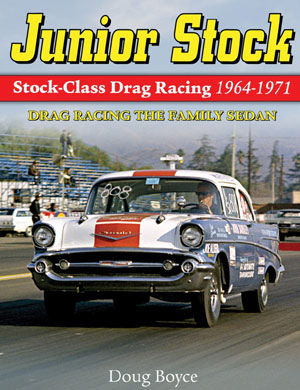
The posters on the Spotlight Hobbies message board are having a Junior Stock “build-off,” building model cars of NHRA Stock class cars raced from 1964 to 1971, before the Stock and Super Stock classes were revamped in 1972. You can replicate an actual car or build one to your liking. Everyone is welcome to participate, whether you’re a regular here or if you’re new to the site. Just build the car, photograph it, and send the photos to Pat Redmond at pdredmond@sympatico.ca or simply post them on the board by July 4, 2013 and they will be added to the album.
The new Doug Boyce book Junior Stock has been the inspiration for the build-off challenge. It contains a plethora of accurate information and details along with hundreds of amazing vintage photos, all very helpful in building your own Junior Stocker.

To determine the class a car would have run in, divide the factory rated horsepower into the manufacturer factory weight that was provided to NHRA each year. By clicking here on the NHRA Classification Guide here or below you can find all the available engines and the NHRA/factory weight for most cars. Don’t go by the hp to weight ratios shown in the chart, as many engines, perhaps even most, have been factored to a more realistic hp rating over the past 45 years, while nearly all used the FACTORY rating during the Jr. Stock era.
To use the classification guide, find the car you’re interested in, then look at the engine choices for each year for Stock (ignore the Super Stock info). The hp shown in the top line for each engine/car is the factory rating. If interested, you can look to the bottom of the columns to see what the factored hp is. But to find the hp to weight ratio for a car back in the day, move the bar at the bottom of your page way over to the right into the “gray” area, and you’ll find the weight for each model and body, and divide that by the original factory hp (not the factored hp). Then go to the charts shown below to see which class the car would have fallen into for a given year.
Here are the Stock Eliminator pages from the 1964 and 1971 NHRA rule books (both ends of the Jr. Stock era), along with some interpretations of the rules that affect visible areas. Further down are the class breaks for each year from 1964 through 1971.
………………1964 rules:

………………1971 rules:

Interpretation of Rules:
Body: Car must remain at near stock height, but an inch or so leeway is allowed. Likewise, the car must be close to level, but it’s okay if the rear is an inch or so higher. It’s okay too, if the right rear is an inch or so higher than the left rear due to wedge or pressure on the right rear to equalize traction by use of an air bag on the right rear or asymmetrical spring setup.
Less customizing was permitted each year, and even though it wasn’t specified that a stock grille was required until 1971, a custom grille would have been frowned upon in earlier years. Customizing or altering stock features was never a good idea anyway because it was a red flag to the tech crew that you may have pushed the rules in other areas too, making them feel they needed to inspect the rest of the car closer.
Exhaust: Not sure about the very early years, but by the mid ’60s or so, contrary to the rule books, the exhaust did not have to be able to be routed through the exhaust pipe/muffler. You actually only need one pipe and stock-type (not glass pack) muffler running from in line with or slightly forward of) the header collector outlet to the rear axle. Most people mounted it to the frame out of the way and NHRA was fine with that because it ensured it wouldn’t fall off. (No serious racer had it mounted any other way.) In '71 no exhaust pipes or muffler were required.
More:
Wheelwell openings must not be altered even the slightest. Inner wheelwell lip may be bent upward to ensure that sharp edges cannot cut tire, and doing so gives slightly greater tire clearance.
All years need a 16 oz. minimum radiator overflow catch can. Even a beer can crudely tied to something in the vicinity of the radiator will do.
A metal strap over the battery to secure it better than the stock GM bracket tie-down is needed.
No drive shaft loop needed at least through 1975.
When using a fuel pressure gauge it needs to be mounted outside the interior (usually mounted on the cowl) so that no fuel line enters the interior area.
At least in later years, windshield wipers were not needed, in fact NHRA preferred you not have them, as that way they can’t fly off on the track.
Here are the weight breaks for every year from 1964 through 1971:

Many thanks to Terry Jessee for coming up with the idea to do this and to Pat Redmond for creating and maintaining the Fotki photo album.
Good luck… and have fun with it!